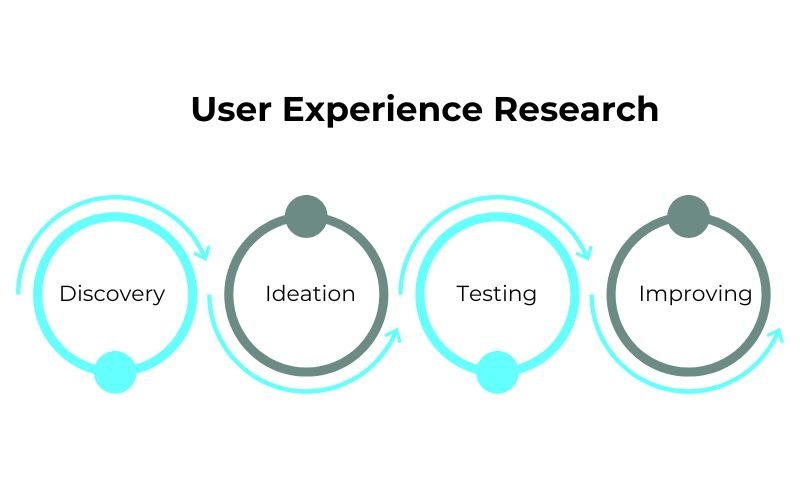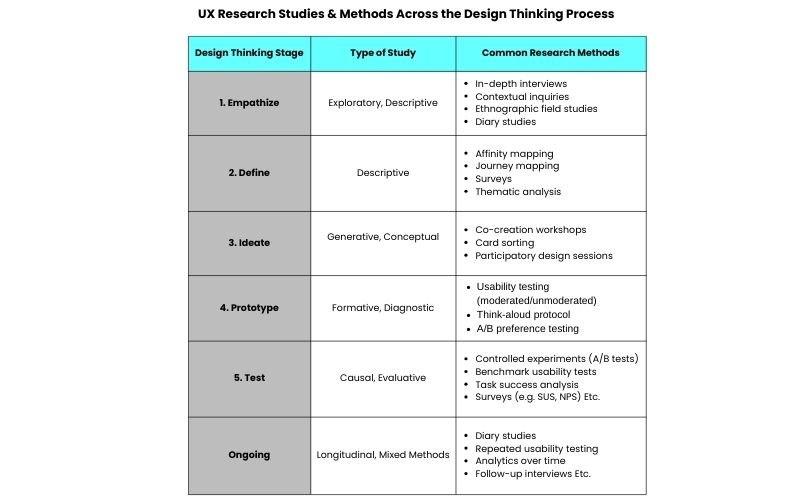
How to Choose the Right UX Research for Your Product or Service
The Costly Guessing Game
Picture this—A promising startup pours months into developing a sleek, cutting-edge app. The launch? A total flop. Why? They built it based on assumptions, not real user insights. Users were frustrated, confused, and abandoned the app faster than you can say, ‘User Experience’—leaving the startup wondering where it all went wrong.
Great design isn’t about luck or gut feelings. It’s about truly understanding your users before you build for them. And that’s where UX research comes in.
This guide will help you avoid the guessing game and choose the right UX research methods tailored to your product’s lifecycle stage—so you build for real people, not personas imagined in a boardroom.
Understanding UX Research: The Right Research vs. The Right Method
You wouldn’t fix a roof with a paintbrush, right? The same logic applies to UX research. It’s not just about doing research—it’s about doing the right research at the right time using the right tools.
Let’s break it down.
The Right UX Research (What You’re Trying to Do)

UX research isn’t one-size-fits-all. Depending on where you are in your product journey, your research goal will shift. These stages help guide the type of research you need:
1. Discovery Phase (Exploratory Research) – Finding the “Why”
Goal: Understand user goals, frustrations, and expectations before designing anything.
Use when:
- Launching a new product
- Entering a new market
- Validating a rough idea
Key questions:
- What are users struggling with?
- What’s missing in their current experience?
Lifecycle alignment: Understand and Empathize phase (Design Thinking)
2. Ideation Phase (Generative Research) – Designing Around Real Needs
Goal: Build concepts, journeys, and wireframes rooted in actual user behavior—not assumptions.
Use when:
- Developing user personas
- Brainstorming feature ideas
- Planning navigation or UI structure
Key questions:
- What does the ideal user journey look like?
- How can we solve this better?
Lifecycle alignment: Define and Ideate phase
3. Prototyping & Usability Testing – Testing the Flow
Goal: Evaluate the ease of use of your wireframes or low-fidelity prototypes.
Use when:
- Testing first designs
- Before investing in high-fidelity mockups
Key questions:
- Are users completing key tasks?
- Where are they getting stuck?
Lifecycle alignment: Prototype phase
4. Final Usability Testing (Validation Research) – Before You Launch
Goal: Validate whether your final design works in the real world.
Use when:
- Before go-live
- After major redesigns
Key questions:
- Does this solution actually solve the user’s problem?
- Is the experience smooth across devices?
Lifecycle alignment: Implement and Validate
5. Post-Launch Monitoring (Descriptive Research) – Observing Real Behavior
Goal: Identify friction, drop-offs, or hidden opportunities in live environments.
Use when:
- After product launch
- When conversion dips unexpectedly
Key questions:
- What are users actually doing?
- Why are users abandoning at certain stages?
Lifecycle alignment: Optimize and Iterate
The Right UX Research Methods (How You Do It)
Once you know what you’re trying to learn (your research stage), you choose the right tool to get the job done.
1. Qualitative Methods – Understanding the “Why”
- In-depth Interviews: One-on-one conversations to understand thoughts, motivations, and behaviors.
- Focus Groups: Guided group discussions for collective insights and validation.
- Contextual Inquiry: Observe users in their real environment while they use your product.
- Diary Studies: Long-term feedback as users interact with your product over days or weeks.
2. Quantitative Methods – Measuring the “What”
- Surveys: Collecting large-scale feedback quickly.
- Analytics: Tracking clicks, drop-offs, and patterns.
- A/B Testing: Comparing two versions of a feature to see which performs better.
- Heatmaps: Visualizing where users click, scroll, or get stuck.
3. Observational & Structural Methods – Seeing What Users Actually Do
- Usability Testing: Watching users complete tasks to uncover friction.
- Card Sorting: Understanding how users mentally organize information.
- Tree Testing: Testing navigational structure without visuals.
- Log Analysis: Analyzing backend data for user behavior patterns.
4. Mixed Methods – Connecting the Dots
Combine qualitative + quantitative for richer insight:
- Surveys + Interviews = Broad and deep understanding
- Analytics + Usability Tests = What’s happening and why
Use when:
- Stakeholders need solid data for decisions
- Designing for multiple personas
- You’re planning a major redesign
UX Research Studies & Methods Across the Design Thinking Process

Criteria for Choosing Your UX Research Method (Filtering Your Options)
Use this checklist to refine your choices even further:
Resources Available
Budget, time, tools, and internal bandwidth.
Target Audience Accessibility
Can you reach your users easily? If not, reconsider the method or audience.
Product Development Stage
Match research type to lifecycle (discovery, ideation, delivery, or optimization).
Scalability
What works for a 5-person startup might not work for a global product. Choose wisely.
Ethics & Compliance
Always get informed consent. Respect privacy laws like GDPR or CCPA. Ethical research builds trust.
Pro Tip: Create a UX research matrix with columns for:
- Goals
- Constraints
- Product stage
- Ideal methods
This gives you a clear view of what fits where.
Turning Research Insights into Action (Bringing It All Together)
Great research is worthless if it sits in a folder collecting digital dust. Here’s how to make it count:
Creating a Feedback Loop
Communicate insights in a digestible way—via storytelling, visual reports, short videos, or highlight reels.
Prioritizing Insights
Use tools like the Impact vs. Effort Matrix to identify quick wins and long-term improvements.
Establishing Design Principles
Turn repeated insights into UX principles (e.g., “always reduce steps,” “show value upfront”) to guide all design work.
Continuous Research
UX research isn’t a one-time effort. Your users evolve—and so should your understanding of them.
Pro Tip:
Build a cross-functional UX research task force—design, product, and research working together—so research becomes a continuous part of development.
Conclusion: Stop Guessing, Start Knowing
Choosing the right UX research method isn’t just a design best practice—it’s a business advantage. By aligning your research strategy with your product’s lifecycle, you make informed decisions, reduce risk, and build experiences your users truly value.
The best products are not built on assumptions. They’re built on insights. Don’t let guesswork guide your roadmap—let your users lead the way.
Ready to Unlock Real User Insights?
At UX Prosperar, we help product teams and businesses take the guesswork out of design. Whether you’re launching a new product, refining an existing one, or just need clarity on what your users actually want—we’re here to guide your UX research journey from discovery to delivery.
Let’s talk about research that drives results.
Contact UX Prosperar today and start building with confidence.







